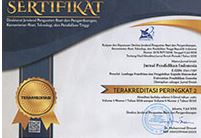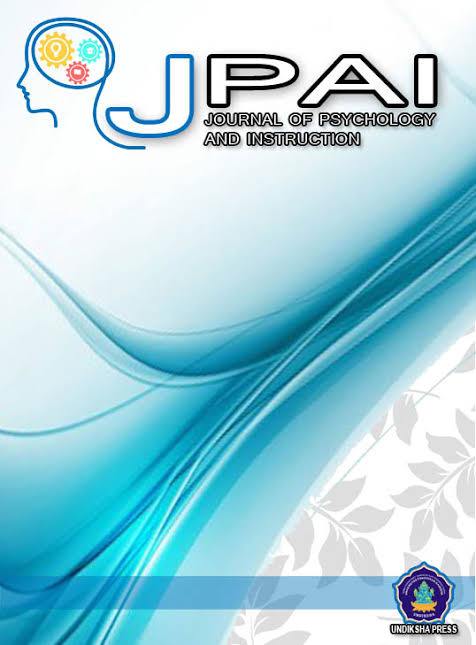Loose-part media and pictures on environmental themes increase interest in early childhood learning
DOI:
https://doi.org/10.23887/jpai.v6i2.52448Keywords:
Loose part media, Pictures media, Learning interestAbstract
Children experience difficulties in learning at school and a lack of interest in children during the learning process. Teachers and parents need to be made aware of this. They think this is because children are lazy when studying. This study analyzed loose part media and pictures on environmental themes to increase interest in early childhood learning. This research method uses quantitative methods with steps to formulate problems, determine the theoretical basis, formulate hypotheses, collect data, conduct data analysis, and draw conclusions. The analysis used in this research is quantitative and qualitative. Includes using loose part media and images, learning observations, and product validation of loose parts media and images. Analysis of loose part media and images to increase interest in early childhood learning includes six stages. The results showed a significant effect of the application of loose part media on environmental themes on children's learning interest based on a t count of 17,812 and a t table of 1.9977, so the t count is more than the t table. The application of environmental theme image media significantly affects children's learning interests with a t table of 1.9995. There is a significant influence of the application of environmental theme loose part media and environmental theme image media on children's learning interest with a t count of 14,483 and a t table of 1.9939. The conclusion is that there is a significant influence of the application of environmental theme loose part media and environmental theme image media on the learning interest of group B students.
References
Aditya Dharma, I. M. (2019). Pengembangan Buku Cerita Anak Bergambar Dengan Insersi Budaya Lokal Bali Terhadap Minat Baca Dan Sikap Siswa Kelas V Sd Kurikulum 2013. Journal for Lesson and Learning Studies, 2(1), 53–63. https://doi.org/10.23887/jlls.v2i1.17321.
Agustina, M., Azizah, E. N., & Koesmadi, D. P. (2021). Pengaruh Pemberian Reward Animasi terhadap Motivasi Belajar Anak Usia Dini selama Pembelajaran Daring. Jurnal Obsesi : Jurnal Pendidikan Anak Usia Dini, 6(1), 353 – 361. https://doi.org/10.31004/obsesi.v6i1.1331. DOI: https://doi.org/10.31004/obsesi.v6i1.1331
Anita Damayanti, Sriyanti Rahmatunnisa, & Lia Rahmawati. (2020). Peningkatan Kreativitas Berkarya Anak Usia 5-6 Tahun Melalui Pembelajaran Jarak Jauh Berbasis Steam Dengan Media Loose Parts. Jurnal Buah Hati, 7(2), 74–90. https://doi.org/10.46244/buahhati.v7i2.1124. DOI: https://doi.org/10.46244/buahhati.v7i2.1124
Aprinawati, I. (2017). Penggunaan Media Gambar Seri Untuk Meningkatkan Kemampuan Berbicara Anak Usia Dini. Jurnal Obsesi : Jurnal Pendidikan Anak Usia Dini, 1(1), 72. https://doi.org/10.31004/obsesi.v1i1.33. DOI: https://doi.org/10.31004/obsesi.v1i1.33
Awe, E. Y., & Benge, K. (2017). Hubungan Antara Minat Dan Motivasi Belajar Dengan Hasil Belajar Ipa Pada Siswa SD. Journal of Education Technology, 1(4), 231. https://doi.org/10.23887/jet.v1i4.12859. DOI: https://doi.org/10.23887/jet.v1i4.12859
Bozkurt Altan, E., & Ercan, S. (2016). STEM education program for science teachers: Perceptions and competencies. Journal of Turkish Science Education, 13(Special issue), 103–117. https://doi.org/10.12973/tused.10174a.
Damayanti, D. (2018). Layanan Informasi dengan Media Gambar untuk Meningkatkan Pemahaman Sex Education Siswa. Indonesian Journal Of Guidance And Counseling: Theory And Application, 7(1), 37–44. https://doi.org/10.15294/IJGC.V8I1.22056. DOI: https://doi.org/10.15294/ijgc.v8i1.22056
Dharma, I. M. A. (2019). Pengembangan Buku Cerita Anak Bergambar Dengan Insersi Budaya Lokal Bali Terhadap Minat Baca dan Sikap Siswa Kelas V SD Kurikulum 2013. Journal for Lesson And Learning Studies, 2. https://doi.org/10.23887/jlls.v2i1.17321. DOI: https://doi.org/10.23887/jlls.v2i1.17321
Febriyanti, C., & Seruni, S. (2015). Peran Minat dan Interaksi Siswa dengan Guru Dalam Meningkatkan Hasil Belajar Matematika. Formatif: Jurnal Ilmiah Pendidikan MIPA, 4(3), 245–254. https://doi.org/10.30998/formatif.v4i3.161. DOI: https://doi.org/10.30998/formatif.v4i3.161
Furi, A. Z., & Harmawati. (2019). Meningkatkan Kemampuan Kognitif melalui Penerapan Metode Eksperimen Menggunakan Media Loose Parts pada Anak Kelompok B. Emphaty Cons: Journal of Guidance and Counseling, 1(2), 7–19. https://e-journal.ivet.ac.id/index.php/emp/article/view/1612.
Kartini, N. L. (2020). Efektivitas Penggunaan Media Gambar dalam Upaya Meningkatkan Hasil Belajar Agama hindu. Indonesian Journal of Educational Development, 1(3), 536 – 543. https://doi.org/10.5281/zenodo.4293721.
Nalipay, M. J. N., Mordeno, I. G., Semilla, J. roel B., & Frondozo, C. E. (2019). Implicit Beliefs about Teaching Ability, Teacher Emotions, and Teaching Satisfaction. Asia-Pacific Education Researcher, 28(4), 313–325. https://doi.org/10.1007/s40299-019-00467-z. DOI: https://doi.org/10.1007/s40299-019-00467-z
Nasution, F. S. (2021). Kasus Bullying ditinjau dari Kecerdasan Emosional dan Kesehatan Mental Anak Usia Dini. MUBTADA: Jurnal Ilmiah Dalam Pendidikan Dasar, 4(4), 57–67.
Ridwan, A., Nurul, N. A., & Faniati, F. (2022). Analisis Penggunaan Media Loose Part untuk Meningkatkan Kemampuan Motorik Halus Anak Usia 5-6 Tahun. Mitra Ash-Shibyan: Jurnal Pendidikan Dan Konseling, 5(2), 105–118. https://doi.org/10.46963/mash.v5i02.562. DOI: https://doi.org/10.46963/mash.v5i02.562
Safitri, D., & Lestariningrum, A. (2021). Penerapan Media Loose Part untuk Kreativitas Anak Usia 5-6 Tahun. Kiddo: Jurnal Pendidikan Islam Anak Usia Dini, 2(1), 40–52. https://doi.org/10.19105/kiddo.v2i1.3645. DOI: https://doi.org/10.19105/kiddo.v2i1.3645
Sumaryanti, L. (2020). Menumbuhkan minat baca anak MI / SD dengan media buku bergambar seri. Journal Basic Of Education, 4(2), 173–183. https://doi.org/10.24269/ajbe.v4i2.2699. DOI: https://doi.org/10.24269/ajbe.v4i2.2699
Syafi’i, I., & Dianah, N. D. (2021). Pemanfaatan Loose Parts Dalam Pembelajaran Steam Pada Anak Usia Dini. AULADA: Jurnal Pendidikan Dan Perkembangan Anak, 3(1), 105–114. https://doi.org/10.31538/aulada.v3i1.1203. DOI: https://doi.org/10.31538/aulada.v3i1.1203
Triana, D., Anggraito, Y. U., & Ridlo, S. (2020). Effectiveness of environmental change learning tools based on STEM-PjBL towards 4C skills of students. Journal of Innovative Science Education, 9(2), 181–187. https://doi.org/10.15294/JISE.V8I3.34048.
Wahyuningsih, S., Pudyaningtyas, A. R., Nurjanah, N. E., Dewi, N. K., Hafidah, R., Syamsuddin, M. M., & Sholeha, V. (2020). The utilization of loose parts media in steam learning for early childhood. Early Childhood Education and Development Journal, 2(2), 1–5. https://doi.org/10.20961/ecedj.v2i2.46326. DOI: https://doi.org/10.20961/ecedj.v2i2.46326
Wardani, A., & Ayriza, Y. (2020). Analisis Kendala Orang Tua dalam Mendampingi Anak Belajar di Rumah Pada Masa Pandemi Covid-19. Jurnal Obsesi : Jurnal Pendidikan Anak Usia Dini, 5(1), 772. https://doi.org/10.31004/obsesi.v5i1.705. DOI: https://doi.org/10.31004/obsesi.v5i1.705
Widiana, W. (2022). Game Based Learning dan Dampaknya terhadap Peningkatan Minat Belajar dan Pemahaman Konsep Siswa dalam Pembelajaran Sains di Sekolah Dasar. Jurnal Edutech Undiksha, 10(1), 1–10. https://doi.org/10.23887/jeu.v10i1.48925.










